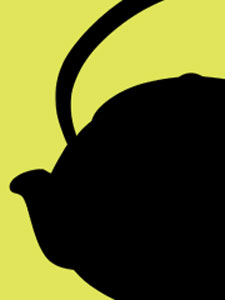Between the Leaves, September 2007
Can I get more than one infusion from my tea leaves? If so how many and how long can I keep the wet leaves?
Yes, you can happily make more than one infusion from most types of loose tea. However, the amount of tasty infusions you will be able to coax from the leaf largely depends on the amount of processing it has undergone.

See, tea leaveslike all true plantshave evolved very efficient methods for keeping water and nutrients inside their tissues. As you may remember from high school biology, the primary difference between plant and animal cells is that a near-impermeable cellulose wall surrounds plant cells. This wall is so strong that plant cells rely on little channels puncturing the wall for gas and nutrient exchange. This highly controlled structure is echoed in a leaf's tissue organization. Both the top and bottom sides of the leaf are protected by a moderately impenetrable waxy cuticle over a layer of tightly packed epidermal cells, and this layer is only broken on the underside of a leaf by stomataor little mouthswhich close and open to allow gas exchange. Basically, what all this means is that without processing to break open the cells and leaf, you don't get any tea deliciousness.
The trick then, is to experiment with different processing methods to break down enough of these barriers to let different amounts of tea goodness through at different times. Naturally, these fall along a spectrum. At one end, you have your classic bagged black teas, which are usually the smallest pieces from CTC, or 'Crush, Tear, Curl' processing, during which whole leaves are smashed to rupture individual cells, chopped into bits, and allowed to fully oxidize. When the torn leaves are introduced to water, everything is released at once in a single infusion. On the other end, you have white teas like Silver needle, which have only been steamed and dried, or full-leaf greens, which usually undergo some sort of firing process. Using a more 'Western' brewing method (little leaf, lots of water, lots of time), you can probably get two or three infusions, but too much cellular and leaf structure remains to get more. Full leaf oolongs, which undergo more cellular breakdowns than greens and whites but still retain a lot of structure, will likely give you the most infusions whether you brew 'Western' or 'Eastern' (lots of leaf, little water, little time).
If you use a Western style and mind your temperatures, you can get 1 infusion from tea bags and chopped black teas (like Keemuns and CTCs), 2 from whole leaf blacks (like Yunnan Gold) and chopped greens (such as senchas), 2-4 for most whole leaf greens and whites and 4-6 for most whole leaf oolongs. Using Eastern methods, you might even find an oolong or puerh that hits 20 infusions. Of course, you can experiment with leaf amount, temperature, and infusion times to see how far you can stretch any tea. But no matter what style and parameters you do choose, always keep your leaves damp, warm if you can, andto inhibit bacteria growthrelatively isolated from air. A covered cup or teapot will serve these purposes excellently. Do not keep the leaves any longer than 12 hours from the first brew, and you should be just fine.
